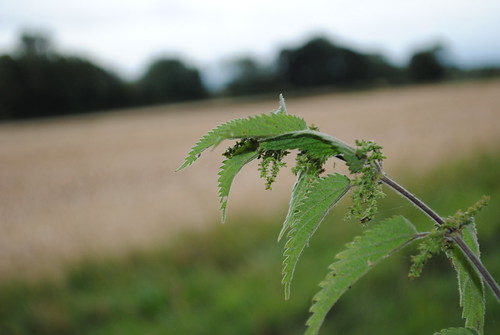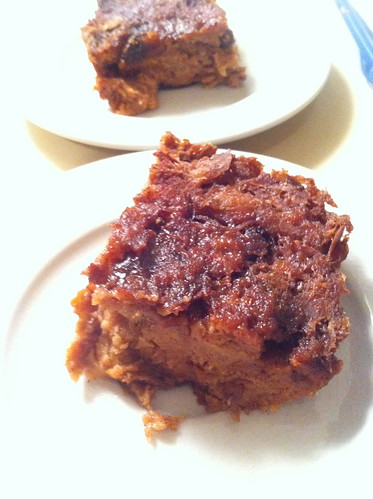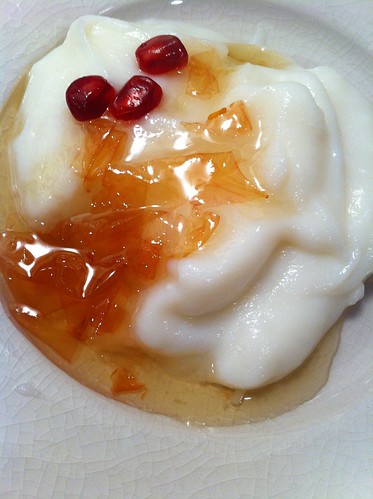Kombucha Recipe
Kombucha in Japanese means "Mushroom Tea". It is a fermented tea beverage that is considered healthful and nutritious in the macrobiotic diet, combining the benefits of tea (antioxidants) and the symbiotic culture of fungi and bacteria that's in the kombucha starter, AKA SCOBY - a weird, jellyfish looking disk that takes the shape of the surface of jar it was last brewed on, and which feeds on sugar and theine (the caffeine which is present in tea). It also has become a lifestyle trademark of Hipsters the world over. Thankfully, it is also delicious and you do not need to be a Hipster to enjoy it. It is also an excellent substitute to more damaging alcoholic drinks, although I should worn you that when fermented for a very long time, kombucha may develop a small amount of alcohol. If you're very sensitive to alcohol, you may be advised against drinking kombucha while driving. How can you tell if your kombucha has alcohol content? You'll start feeling a tiny bit lightheaded, and probably feel like you should get off the road. In other words: your judgement would never be impaired to the point of thinking you're an excellent driver while under the kombucha influence. We're talking about 0.5% alcohol at the most... Although I hear black teas can turn kombucha into a little higher. In which case, you might not want to serve it in a baby-bottle to your toddler. So if your little one gets drowsy after their afternoon kombucha infusion, this may be a sign that the alcohol content have exceeded the caffein levels in your brew. Wait, are babies even allowed caffein?!
But I digress with my ridiculous (and often misunderstood) jokes. You probably want me to tell you already how to make kombucha and custom-flavour it. So before we start, I want to refer you to an excellent video by CutlruesForHealth. It really is a great way to learn about how to make kombucha. They also have an excellent FAQ section.
Important Tip: ALWAYS sterilize ALL your dishes, tools and containers before preparing and bottling your kombucha! This is the number one reason for kombucha fail. Otherwise, it should be as simple as making an iced tea (and then forgetting about it for a week...).
Ingredients:
2 liters of spring water or filtered water, boiled to the temperature required (i.e.: boiling water for black teas, 190 F for Oolongs, 185 F for white teas and 175 F for green teas).
Tip: Boil a little extra water for sterilizing all your tools and containers!
2 heaping tsp loose leaf tea
1/2 cup sugar (I use evaporated cane sugar - don't use any brown sugar or honey - these will change the acidity level and may spoil your kombucha and SCOBY)
1/4 cup kombucha from previous batch (or, if this is your first time making kombucha: use 1/4 cup of unpasteurized, unfiltered apple cider vinegar - preferably organic)
1 SCOBY (kombucha mother culture) - which you will have to get from a friend, or purchase dried online (follow instructions on the package on how to make this come to life!)
Tools and Equipment:
A 2 liter glass or ceramic pot large enough for your desired quantity
Kettle for warming and boiling the water for sterilization
Measuring cups and teaspoons
Tea strainer and/or medium sized fine mesh sieve
Coffee filter or clean cotton cloth for covering your kombucha container, and an elastic band to secure it to the jar
Funnel (optional: I use the spout of the measuring cup to bottle my kombucha)
Bottles or jars for bottling your kombucha
Tongs
Procedure:
Step 1: Sterilize with boiling water all your tools, dishes, jars and containers used to handle the SCOBY and ferment the kombucha
Step 2: Prepare your water and steep the tea
Step 3: Add the sugar to the tea, and wait until it is completely dissolved and the tea have cooled down to room temperature
Step 4: Add the pre-made (unlfavoured) kombucha from previous batch (or apple cider vinegar if this is your first time brewing kombucha)
Step 5: Add the SCOBY - I handle mine with a pair of sterilized tongs
Step 6: Cover the jar with the coffee filter or a cotton cloth that is breathable but still prevents dust and fruit flies from diving in.
Step 7: Place in a warm place for at least 7 days (I use the top of the fridge).
Step 8: Taste the kombucha after a week, and see if you like the taste of it. The more mature it is, the more sugars it will digest and transform - and therefore it will develop more of its fermented, acidic taste.
But I digress with my ridiculous (and often misunderstood) jokes. You probably want me to tell you already how to make kombucha and custom-flavour it. So before we start, I want to refer you to an excellent video by CutlruesForHealth. It really is a great way to learn about how to make kombucha. They also have an excellent FAQ section.
Important Tip: ALWAYS sterilize ALL your dishes, tools and containers before preparing and bottling your kombucha! This is the number one reason for kombucha fail. Otherwise, it should be as simple as making an iced tea (and then forgetting about it for a week...).
2 liters of spring water or filtered water, boiled to the temperature required (i.e.: boiling water for black teas, 190 F for Oolongs, 185 F for white teas and 175 F for green teas).
Tip: Boil a little extra water for sterilizing all your tools and containers!
2 heaping tsp loose leaf tea
1/2 cup sugar (I use evaporated cane sugar - don't use any brown sugar or honey - these will change the acidity level and may spoil your kombucha and SCOBY)
1/4 cup kombucha from previous batch (or, if this is your first time making kombucha: use 1/4 cup of unpasteurized, unfiltered apple cider vinegar - preferably organic)
1 SCOBY (kombucha mother culture) - which you will have to get from a friend, or purchase dried online (follow instructions on the package on how to make this come to life!)
Tools and Equipment:
A 2 liter glass or ceramic pot large enough for your desired quantity
Kettle for warming and boiling the water for sterilization
Measuring cups and teaspoons
Tea strainer and/or medium sized fine mesh sieve
Coffee filter or clean cotton cloth for covering your kombucha container, and an elastic band to secure it to the jar
Funnel (optional: I use the spout of the measuring cup to bottle my kombucha)
Bottles or jars for bottling your kombucha
Tongs
Procedure:
Step 1: Sterilize with boiling water all your tools, dishes, jars and containers used to handle the SCOBY and ferment the kombucha
Step 2: Prepare your water and steep the tea
Step 3: Add the sugar to the tea, and wait until it is completely dissolved and the tea have cooled down to room temperature
Step 4: Add the pre-made (unlfavoured) kombucha from previous batch (or apple cider vinegar if this is your first time brewing kombucha)
Step 5: Add the SCOBY - I handle mine with a pair of sterilized tongs
Step 6: Cover the jar with the coffee filter or a cotton cloth that is breathable but still prevents dust and fruit flies from diving in.
Step 7: Place in a warm place for at least 7 days (I use the top of the fridge).
Step 8: Taste the kombucha after a week, and see if you like the taste of it. The more mature it is, the more sugars it will digest and transform - and therefore it will develop more of its fermented, acidic taste.
Step 9: Bottle the Kombucha into sterlized glass containers. Reused wine bottles and sling-top beer bottles are a good Hipstery-looking option, though a bit hard to fill (you'll need a funnel), not to mention clean. To make matters worse - if you throw the sling-top bottles in a dishwasher, their aluminum parts will oxidize - yikes!. I reuse tomato-juice bottles or any other glass juice bottles, and am also happy that I don't need to use a funnel to fill them (the spout of a measuring cup is perfect for this task).
Step 10: Additional flavouring. At this point, if you haven't been using a flavoured tea and want your kombucha to taste like something else besides tea, you may add a little bit of fruit juice, sprigs of herbs, spices and whatnot. Added sugar from fruit juice or honey will continue the fermentation process and will also help to boost up the fizz in the next step!
Step 11: To achieve the bubbly, soda or champagne-like fizz effect, you will need to continue with one more step: age the kombuch, with tightly closed lids, for 24-48hrs.
Note about flavouring kombucha:
The key here is to have a good, healthy kombucha, and use the finest tea you can get. Another important component of a successful flavoured kombucha-making is that if you are using flavours, only to make them occasionally. The oils in flavoured teas do not add to the health of the culture. So you must alternate between making flavoured ones to plain ones.
Ideas for flavouring: Follow the recipe for kombucha provided on this blog, using high quality jasmine-scented tea. You may also use flowering (hand-tied) teas, though this may be a bit of a waste of a beautiful thing (visually speaking), and either white, green or black jasmine teas. They will take on the character of the tea leaf and the flavouring. To the jasmine tea you may want to add a tropical fruit juice, such as mango or guava.
I've also enjoyed immensely a Lavender Early Gray flavoured kombucha.
The key here is to have a good, healthy kombucha, and use the finest tea you can get. Another important component of a successful flavoured kombucha-making is that if you are using flavours, only to make them occasionally. The oils in flavoured teas do not add to the health of the culture. So you must alternate between making flavoured ones to plain ones.
Ideas for flavouring: Follow the recipe for kombucha provided on this blog, using high quality jasmine-scented tea. You may also use flowering (hand-tied) teas, though this may be a bit of a waste of a beautiful thing (visually speaking), and either white, green or black jasmine teas. They will take on the character of the tea leaf and the flavouring. To the jasmine tea you may want to add a tropical fruit juice, such as mango or guava.
I've also enjoyed immensely a Lavender Early Gray flavoured kombucha.




